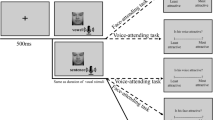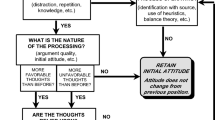Abstract
This research examines the impact of spontaneous nonverbal expressiveness and physical attractiveness on the formation of initial interpersonal impressions. It was hypothesized that in the absence of a relationship history with a person, those people who provide more spontaneous, uncensored, nonverbal information would be viewed as more interpersonally attractive. In addition, as a secondary focus of the study, data were analyzed to examine the relationship between physical attractiveness and nonverbal communication abilities. Results suggest that both physical attractiveness and nonverbal expressiveness independent of one another and in conjunction with one another positively impact on interpersonal perceptions. In addition, physical attractiveness was found to positively covary with nonverbal encoding accuracy but negatively covary with nonverbal decoding abilities.
Similar content being viewed by others
References
Adams, G.R. Physical attractiveness research: Toward a developmental social psychology of beauty.Human Development, 20, 217–239.
Argyle, M.Bodily Communication. London: Methuen, 1975.
Bayes, M.A. Behavioral cues of interpersonal warmth.Journal of Consulting and Clinical Psychology, 1972,29, 333–339.
Berscheid, E. & Walster, E. Physical attractiveness. In L. Berkowitz (Ed.),Advances in experimental social psychology, Vol. 6. NY: Academic Press, 1974.
Brideau, L.B. & Allen, V.L. Individual differences in nonverbal communication: Facial and vocal encoding.Wisconsin Research and Development Center for Individualized Schooling, Technical Report No. 567, 1980.
Buck, R. The evolution and development of emotion expression and communication. In S. Brehm, S. Kassin, and F. Gibbons (Eds.),Developmental social psychology. New York: Oxford University Press, 1981.
Buck, R. Individual differences in nonverbal sending accuracy and electrodermal responding: The externalizing-internalizing dimension. In R. Rosenthal (Ed.),Skill in nonverbal communication: Individual differences. Cambridge, MA: Oelgeschlager, Gunn, & Hain, 1979a.
Buck, R. Measuring individual differences in the nonverbal communication of affect.Human Communication Research, 1979b,6, 47–57.
Buck, R. A test of nonverbal receiving ability: Preliminary studies.Human Communication Research, 1976,2, 162–171.
Buck, R., Miller, R.E. & Caul, W. F. Sex, personality, and physiological variables in the communication of emotion via facial expression.Journal of Personality and Social Psychology, 1974,30, 587–596.
Buck, R., Savin, V.J., Miller, R.E., & Caul, W.F. Nonverbal communication of affect in humans.Journal of Personality and Social Psychology, 1972,23, 362–371.
Ekman, R., & Friesen, W.V. Detecting deceptions from the body or face.Journal of Personality and Social Psychology, 1974,29, 288–298.
LaCrosse, M.B. Nonverbal behavior and perceived counselor attractiveness and persuasiveness.Journal of Counseling Psychology, 1975,22, 563–566.
Larrance, D.T. & Zuckerman, M. Facial attractiveness and vocal likeability as determinants of nonverbal sending skills.Journal of Personality, 1981,49, 349–362.
Poling, T.H. Sex differences, dominance, and physical attractiveness in the use of nonverbal emblems.Psychological Reports, 1978,43, 1087–1092.
Reis, H.T., Wheeler, L., Speigel, N., Kernis, M.H., Nezlek, J., & Perri, M. Physical attractiveness in social interaction: II. Why does appearance affect social experience.Journal of Personality and Social Psychology, 1982,40, 979–996.
Sabatelli, R.M., Buck, R., & Dreyer, A. Nonverbal communication accuracy in married couples: Relationship with marital complaints.Journal of Personality and Social Psychology, 1982,43, 1088–1097.
Strong, S.R., Taylor, R.G., Bratton, J.C., & Loper, R.G. Nonverbal behavior and perceived counselor characteristics.Journal of Counseling Psychology, 1971,18, 554–561.
Shrout, P.E. & Fiske, D.W. Nonverbal behaviors and social evaluations.Journal of Personality, 1981,49, 115–128.
Zuckerman, M., Hall, J.A., DeFrank, R.S., & Rosenthal, R. Encoding and decoding of spontaneous and posed facial expressions.Journal of Personality and Social Psychology, 1976,34, 966–977.
Author information
Authors and Affiliations
Additional information
The authors wish to express their appreciation to Ross Buck and Robert Ryder for their helpful comments on an earlier draft of the paper.
Rights and permissions
About this article
Cite this article
Sabatelli, R.M., Rubin, M. Nonverbal expressiveness and physical attractiveness as mediators of interpersonal perceptions. J Nonverbal Behav 10, 120–133 (1986). https://doi.org/10.1007/BF01000008
Issue Date:
DOI: https://doi.org/10.1007/BF01000008




